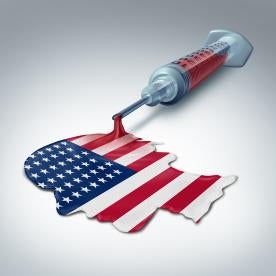In this post, I will be focusing on the intersection of off-label communications with government enforcement of health care fraud through the False Claims Act. Over the past eight years, the U.S. Department of Justice (“DOJ”) has been particularly aggressive in using the False Claims Act to pursue recoveries from individuals, health care providers, and drug manufacturers that participate in federal health benefit programs. In fact, from 2009 to 2016, DOJ collected $19.3 billion from health care False Claims Act settlements and judgments, with $2.5 billion recovered in fiscal year 2016, alone. (More DOJ false claims statistics can be found here.) DOJ’s enforcement efforts are not solely targeted against garden variety billing fraud, but also involve claims arising from alleged violations of health care regulatory requirements. Among other things, the DOJ has been targeting claims for reimbursement for off-label uses of regulated products. DOJ’s aggressive policy of holding manufacturers accountable for off-label claims under the False Claims Act is entirely consistent with FDA’s stance on off-label communications as described in the January memo. However, recent court interpretations of off-label communications as protected First Amendment speech, as well as interpretations of the causality component of False Claims Act claims, have apparently caused DOJ to reconsider its strategy with respect to such cases.
The False Claims Act
The False Claims Act is the federal government’s primary means of recovering payments made to persons or entities who fraudulently bill branches or agencies of the U.S. government for goods or services. The False Claims Act covers any type of goods and services provided to the federal government, not only health care goods and services. The statute is codified as 31 U.S.C. §§ 3729–33 and is written to encompass a broad scope of fraudulent conduct. In the majority of False Claims Act cases involving goods and services related to health care, violations of the following False Claims Act provisions are cited:
31 U.S.C. § 3729. False claims
(a)(1) [A]ny person who—
(A) knowingly presents, or causes to be presented, a false or fraudulent claim for payment or approval;
(B) knowingly makes, uses, or causes to be made or used, a false record or statement material to a false or fraudulent claim;
(C) conspires to commit a violation of [Section 3729(a)(1)];
. . .
is liable to the United States Government for a civil penalty of not less than $5,000 and not more than $10,000 . . . plus 3 times the amount of damages which the government sustains because of the act of that person.
Although physicians are permitted to prescribe drugs for off-label use, the government takes the position that when off-label promotions influence (or may influence) the physician to prescribe off-label, the manufacturer interferes with or alters the physician’s professional judgment and causes reimbursement claims for drugs prescribed for off-label uses to be submitted to the government. Since an impermissible off-label use is not considered a “medically accepted indication” (42 U.S.C. § 1396r-8(k)(6)), claims to the U.S. government for reimbursement of off-label uses induced (or potentially induced) by manufacturer promotions are allegedly false claims for which the manufacturer is liable.
Each individual false claim to the U.S. government carries a penalty of $10,781.40 to $21,562.80 and False Claims Act damages are trebled, so claimed damages and penalties related to off-label promotion charges can reach into the millions very quickly. It is important to note that the False Claims Act carries a civil, not a criminal, penalty. However, DOJ can add criminal charges by claiming that the manufacturer’s off-label promotions render the drug misbranded under the Food, Drug, and Cosmetic Act (the “FDCA”).
Causation and Materiality in False Claims Act Cases
The theory that off-label communications directly induce physicians to prescribe drugs for off-label uses, and thus cause pharmacists to bill government programs for drugs provided for such uses, was recognized as a legitimate theory of causation by the U.S. District Court for the District of Massachusetts in U.S. ex rel.Franklin v. Parke-Davis (147 F. Supp. 2d 39 (D. Mass. 2001)). In response to Parke-Davis’s argument that the independent actions of the physician (who is permitted by law to prescribe drugs for off-label uses) and the pharmacist broke the chain of causation with respect to the off-label communications, the court responded as follows:
[S]uch an intervening force only breaks the causal connection when it is unforeseeable. In this case . . . the participation of doctors and pharmacists in the submission of false Medicaid claims was not only foreseeable, it was an intended consequence of the alleged scheme of fraud. Franklin, 147 F. Supp. 2d 52-53 (citations omitted).
The court’s interpretation of the chain of causation confirmed the manufacturer’s liability under the False Claims Act for making the off-label communications, presumably even if the physician did not rely on such communication when deciding to prescribe a drug off-label.
However, judicial opinion appears to be moderating with respect to broad False Claims Act liability for off-label promotion. In 2016, a panel of the U.S. Circuit Court of Appeals for the Second Circuit decided U.S. ex rel. Polansky v. Pfizer (822 F.3d 613 (2d Cir. 2016)) in an opinion that appeared to move away from the theory of causation described in Franklin. Polansky claimed that Pfizer was promoting Lipitor off-label because its communications to doctors were not in line with the National Cholesterol Education Program (“NCEP”) Guidelines, which were referenced in Lipitor’s labeling. The court held that NCEP’s advisory guidance did not become restrictive instructions determining whether a particular prescription is on- or off-label simply because the labeling contained a reference to the guidance. However, the opinion also includes noteworthy dicta describing a narrower interpretation of manufacturer causation and liability than the one adopted by the Franklin court:
We are skeptical . . . that even under Polansky’s theory of the case, anyone could be identified who actually submitted a false claim. The FDA does not prohibit physicians, who are free to do so, from prescribing Lipitor for patients with normal cholesterol. Accordingly, it is unclear just whom Pfizer could have caused to submit a false or fraudulent claim: The physician is permitted to issue off-label prescriptions; the patient follows the physician’s advice, and likely does not know whether the use is off-label; and the script does not inform the pharmacy at which the prescription will be filled whether the use is on-label or off. [W]e are dubious of Polansky’s assumption that any one of these participants in the relevant transactions would have knowingly, impliedly certified that any prescription for Lipitor was for an on-label use. Polansky, 822 F.3d 619-20 (citations and quotations omitted).
The court went on to state that the False Claims Act was never intended as a “back-door regulatory regime” and that FDA is responsible for enforcing compliance with regulations (Polansky, 822 F.3d 620).
The U.S. Supreme Court’s opinion in Universal Health Services v. United States ex rel. Escobar (136 S. Ct. 1989 (2016)) may also present a new obstacle to government and relator False Claims Act claims related to off-label communications. Under the False Claims Act, any alleged violation based on a theory that falsity arises as a result of an implied certification of compliance that is false must establish that the non-compliance was material to the government’s decision to pay the claimant. However, the Escobar opinion states that while the U.S. government’s identification of a condition of payment (e.g., reimbursement is only permitted for medically accepted, FDA approved indications) is relevant to materiality, the government’s actions with respect to such claims is just as, if not more, relevant. Thus, if the government consistently pays claims even though it knows the claims do not meet the conditions of payment, “that is strong evidence that the requirements are not material” (Escobar, 136 S. Ct. 2004). In theory, for False Claims Act cases based in part on off-label claims, evidence that the government knows certain drugs are prescribed and used off-label but regularly pays claims for such drugs anyway may allow manufacturer’s to successfully refute materiality. This theory carries two significant caveats: (1) the claims at issue in Escobar concerned healthcare services, not drugs, so courts may interpret materiality differently in off-label promotion cases; and (2) pharmacy billing information does not indicate whether a drug was used on- or off-label, and federal programs like Medicare do not typically reconcile drug reimbursement requests with corresponding patient records to determine whether a prescription was off-label, potentially weakening a manufacturer’s materiality defense.
Possible Effects of Polansky IV and Escobar on False Claims Act Cases
Although recent court opinions in Polansky and Escobar appear to signal a shift in judicial thinking about the breadth of liability in False Claims Act cases, relators and government entities continue to claim off-label communications as components of larger fraudulent schemes by manufacturers. The following settlements with manufacturers were reached from Q2 2016 to Q3 2017, all of which included civil penalties and consent decrees under the False Claims Act to resolve charges, among other things, that off-label promotion caused false claims to be submitted to the U.S. government:
Even though DOJ has extracted some significant settlements from drug manufacturers in the past year, these specific cases included neither criminal charges nor claims for violations of the FDCA. It’s possible that the recent interpretations of False Claims Act liability in Polansky and Escobar may have deterred DOJ from seeking greater penalties due to the higher burden of proof. In addition, the rulings in Caronia and Amarin, which I covered in a previous post, may have convinced DOJ to reconsider claims that manufacturers violated the FDCA through off-label communication unless it is clear that such communications were false or misleading. However, including off-label promotion claims as part of civil false claims charges increases the total amount DOJ can demand in settlement, so it stands to reason that DOJ will continue to bring such civil charges against manufacturers.
It may be too soon to understand the full effect of Polansky, Escobar, Caronia, and Amarin on legal strategies involving the False Claims Act, but one can expect that the contrast between the government’s hardening position on off-label communications (as demonstrated by FDA’s January memo) and the judiciary’s evolving interpretation of the First Amendment, causation, and materiality in off-label promotion cases will produce significant changes in false claims litigation.




 />i
/>i

